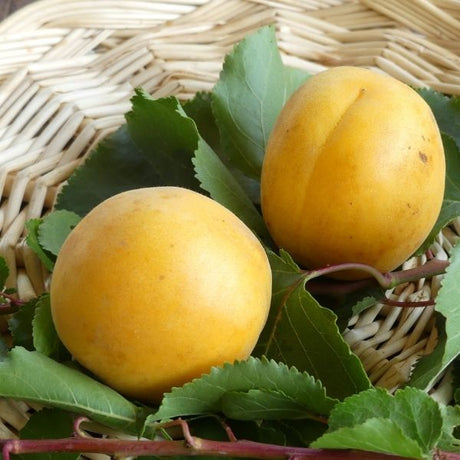- Sold out
- Sold outRegular price From $14999Unit price /Unavailable
- Sold out
- Sold out
- Regular price From $7990Unit price /Unavailable
- Sold outRegular price $14999Unit price /Unavailable
- Sold out
- Sold outRegular price $14999Unit price /Unavailable
- Regular price $14999Unit price /Unavailable
- Sold outRegular price From $14999Unit price /Unavailable
Canadian White Blenheim Apricot Tree
Regular price $14999Unit price /Unavailable- Regular price $24991Unit price /Unavailable
Shop Apricot Trees at Nature Hills Nursery

Apricot trees have a long history of cultivation. Apricots seem to have originated in China and then propagated throughout central Asia thanks to their nutritious fruit and stately profile. From there, the Romans spread them into Europe.
Its scientific name, Prunus armeniaca, derives from the Armenian language because apricot trees were cultivated in Armenia since ancient times. It was thought the fruit originated in that land until genetic studies confirmed its birthplace in Asia.
Perhaps dwarfed by the more popular peach trees, apricot trees are underrated. But these trees offer gorgeous spring and summer flowers, lush emerald leaves and deliciously healthy fruit. Add one to your property today!
Tasty, Healthy Apricots
Apricot fruit is very tasty, and they are now widely grown and consumed in the United States. Apricot tree flowers are white or pink, and the trees produce a stone-fruit with soft flesh that ripens to an orange-yellow color. Apricots contain good amounts of vitamin A and kalium and are also an excellent source of minerals like calcium, phosphorus, iron and traces of sodium, sulfur, manganese, cobalt and bromine. Apricots do not store well, so they are typically eaten fresh, dried or frozen. Apricots are a staple of the jam industry.
Browse our inventory of apricot tree varieties that are appropriate for a wide range of USDA planting zones.

Caring for Apricot Trees
Apricot trees need well-drained soil for optimum health and production. The soil should be moderately fertile. It is best to thin the fruit early in the season to maximize size and quality. Thin the fruits enough so each individual fruit has about three to five inches of room. Apricot trees are quite handsome trees in the summer, displaying the furrowed bark and heart shaped glossy leaves any aficionado has come to recognize. Pruning fruit trees with care and diligence can ensure better crops and an overall healthier tree. A number of apricot-plum hybrids, such as plum-cot, Pluot and Aprium, have been developed and are gaining popularity. These apricots trees are all orchard quality trees.
The Nature Hills Guarantee
At Nature Hills Nursery, we’re committed to helping you select, plant and care for the best plants, trees and shrubs for your property. Shop our apricot trees with the peace of mind that Plant Sentry™ brings in making sure we are compliant with all federal, state and local regulations, including invasive species and quarantine requirements.
We want you to be delighted with every apricot tree, rose bush and perennial plant you purchase form us. That’s why we guarantee every plant through its first year.
Join thousands of happy customers in finding the perfect apricot tree to add joy to your landscape or orchard.
FAQS for Buying Apricot Trees Online
How long does it take for an apricot tree to bear fruit?
How long does it take for an apricot tree to bear fruit?
Apricot trees generally begin producing fruit within 2 to 5 years after planting, depending on the variety and rootstock. Dwarf varieties may produce fruit sooner, while standard trees can take a bit longer. For the best yield, proper pruning, regular watering, and full sun exposure are essential from the beginning.
Do you need two apricot trees for pollination?
Do you need two apricot trees for pollination?
Most apricot trees are self-pollinating, meaning you typically only need one tree to produce fruit. However, planting a second compatible apricot tree nearby can increase fruit production and improve pollination rates, especially in areas with limited pollinator activity or variable spring weather.
What are the best growing conditions for apricot trees?
What are the best growing conditions for apricot trees?
Apricot trees thrive in full sun and require well-drained, moderately fertile soil to flourish. They prefer climates with cold winters and warm, dry summers. Ensure your planting site receives at least 6–8 hours of sunlight per day, and avoid areas with standing water or heavy clay soil.
How do you care for apricot trees to increase fruit quality?
How do you care for apricot trees to increase fruit quality?
To boost fruit quality and size, thin the apricots early in the growing season so that each fruit has about 3 to 5 inches of space around it. Regular pruning improves airflow, reduces disease risk, and promotes healthier crops. Water deeply during dry periods and apply mulch to retain soil moisture.
When is the best time to plant apricot trees?
When is the best time to plant apricot trees?
The ideal time to plant apricot trees is in early spring or fall, when the soil is workable and not frozen. Bare root trees should be planted in late winter to early spring, while potted trees can be planted from spring to early fall, allowing enough time for root establishment before winter.



























